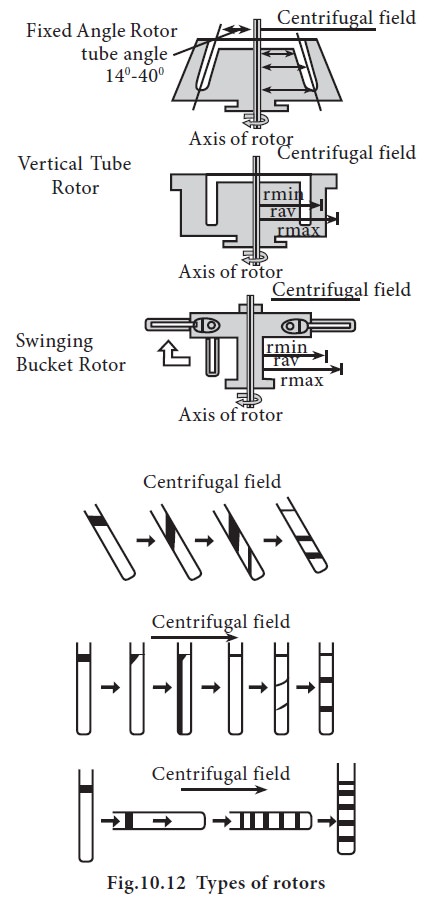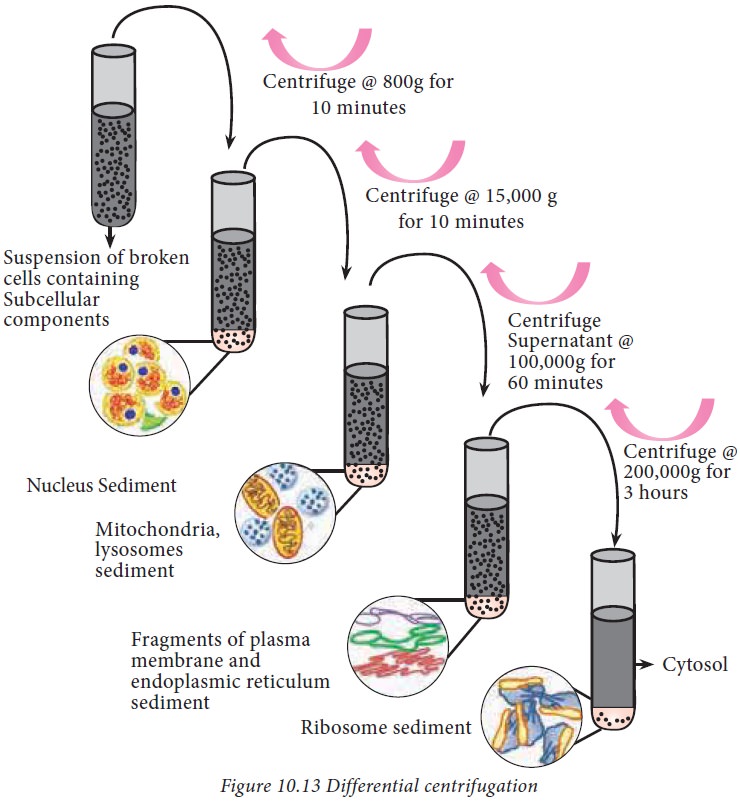Chapter: 11th Biochemistry : Chapter 10 : Biochemical Techniques
Centrifugation techniques: Principle and Types
Centrifugation techniques
1. Principle
Centrifugation is a separation
technique based on the properties of the particle in an applied centrifugal
field. Particles which differ in size, shape and density sediment at different
rates in a medium held in a tube. The rate of sedimentation depends upon the
applied centrifugal field, density and radius of the particle as well as the
density and viscosity of the suspending medium. The rate of sedimentation can
be expressed as rpm (revolutions per minute) or g (gravitational force). The
rate of sedimentation is dependent upon the centrifugal field (G) which is
determined by the square of the angular velocity of the rotor (s) and radial distance (r) from the axis of rotation, expressed
in the equation G = ω2r
The instrument used to hold the
sample and generate the centrifugal force is called the centrifuge. This is
accomplished through the use of various rotors of specific diameter. A rotor
can hold the sample and spin along its own axis at different speeds to generate
centrifugal force.
2. Types of Rotors:
Rotors are important components in a
centrifuge and there are several types of rotors. The schematic representation
of rotors used in centrifuge is shown in Fig.10.12.
1. Fixed angle rotor: In fixed angle rotor, particles move radially outward under the influence of a centrifugal field. The
tubes are held at the angle 20 to 45 degrees. Particles have only a short
distance to travel, to form a pellet at the bottom of the tube.
2. Swinging bucket rotor: The swinging bucket rotor, starts off in a vertical position and during acceleration of the rotor
swing out to a horizontal position. During centrifugation, the solution in the
tube, is aligned perpendicular to the axis of rotation and parallel to the
applied centrifugal field, the tube returning to its original position as the
rotor slows down.
3. Vertical rotor: Vertical rotor presents the shortest possible path for a particle. In
this rotor, the pellet is deposited
along the entire length of the tube.
4. Zonal rotor: The zonal rotors may be of the batch or continuous flow type.
They are designed to minimize the
wall effect that is encountered in swinging-bucket and fixed angle rotors, and
to increase sample size.

3. Types of Centrifugation:
Two main centrifugation techniques
are in general use
a. Preparative
centrifugation: This technique is used for separation, isolation and
purification of whole cells, plasma membrane, ribosomes, nucleic acids, and
many subcellular organelles.
b. Analytical
centrifugation: This technique is used to study the characteristic feature of a
pure macromolecule. Specially designed rotors and detector systems are needed
to continuously monitor the process of sedimentation of the material in the
centrifugal field.
i. Differential centrifugation:
Differential
centrifugation is based on the difference in the sedimentation rate of the
particles of different size and density. It is used for the isolation of
sub-cellular organelles. The centrifugal force is proportional to the radius of
the centrifugal head and to the square of angular velocity. Therefore, it is
possible to use small rotor heads at very high speeds.

The rotor heads are run in a vacuum.
The tube containing the homogenate is held at an angle to the axis. This
technique is commonly used for collecting cells or producing subcellular
fractions from a tissue homogenate. For example, homogenizing a rat liver at
relatively low speed will pellet the larger dense nuclei and centrifugation at
higher speed will sediment particles to further lower size (Fig.10.13)
ii. Density gradient centrifugation
This technique was developed by
Scientist Brakke in the year 1960, where he proposed three ways through which
density gradients may be used.
a. Rate zonal density gradient centrifugation:
This type of centrifugation involves,
layering of sample solution on the top of the gradient, where the density
continuously increases towards the bottom of the tube. It is used to measure
the rate of sedimentation for separation of particles with different
sedimentation co-efficient.
b. Isopycnic density gradient centrifugation:
Isopycnic (Equal) density gradient
centrifugation depends on the buoyant density of the particle and not on the
size and shape of the particle. This centrifugation is used for the separation
of similar size particles which differ in their densities
c. Equilibrium iso-density centrifugation:
In equilibrium iso-density
centrifugation, the sample is mixed with gradient medium to give a solution of
uniform density. The gradient is self-forming during centrifugation. Salts of
heavy metals like caesium, sucrose, and silica are used as the gradient
material. Comparison of rate zonal density gradient centrifugation and
isopycnic gradient centrifugation is represented in Fig.10.14

4. Analytical Ultra centrifugation:
Analytical
ultracentrifugation, developed by Svedberg, is a versatile method for the
separation of small particles such as particles of 10 microns in size. It can
operate safely at about rotor speeds upto 60,000 – 10,00,000 rpm. Protein
molecules, under the influence of high centrifugal force can be made to
sediment toward one end of a centrifuge tube. The rate of sedimentation for a
protein under a certain centrifugal force depends on the density, shape and
size of the molecule. It is used to determine the sedimentation co-efficient
and molecular weight of the macromolecules in solution.
Related Topics